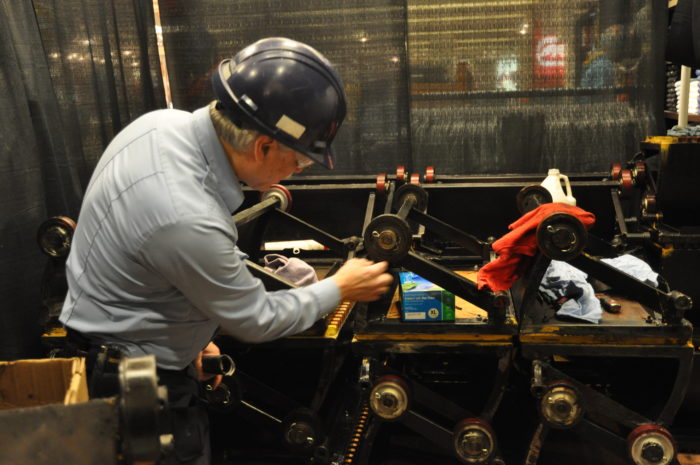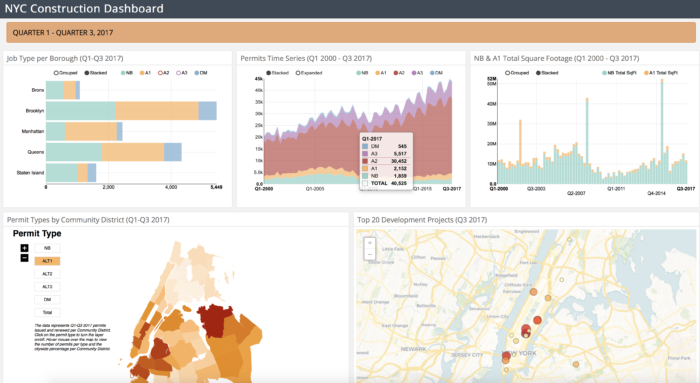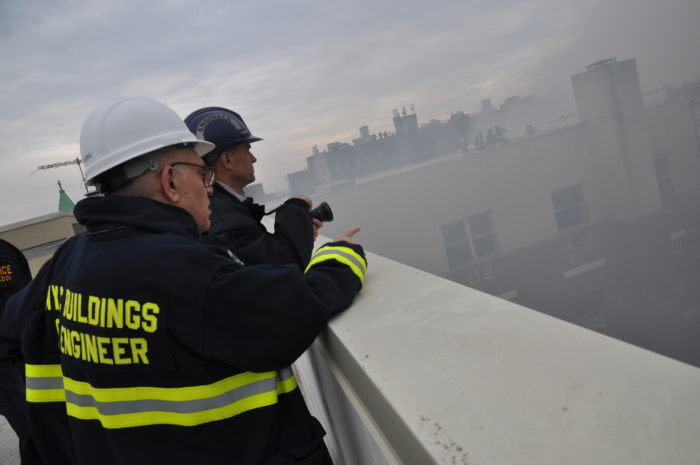In terms of public esteem, New York City’s building inspectors are a far cry from, say, the firefighters. Their employer, the Department of Buildings (DOB), has been synonymous with sluggishness. In 2016, when city Comptroller Scott Stringer convened a Red Tape Commission and surveyed 300 local entrepreneurs about city agencies, the DOB came in at the bottom of the rankings, among the “least satisfying to engage.”
But Mayor de Blasio has promised to fix the agency–an especially urgent need in the midst of the city’s building boom. “What we need, and what we will have, is fundamental reform at the Department of Buildings,” he said in his 2015 State of the City speech. He pledged to put money into it: $120 million over four years, including the hiring of 320 new staffers. The previous year, the city got a new DOB commissioner, Rick Chandler, a civil engineer who had been managing about 10 million sq. ft. of facilities at Hunter College.
For Chandler, who had earlier headed borough-level offices for the DOB, it was a big step up in scope. New York City has about 1 million buildings and 85,000 elevators to inspect, along with boilers, building facades and other facilities, said Chandler. He spoke last week to members of the Brooklyn Chamber of Commerce gathered at the NYU Tandon School of Engineering, where he made a case for the DOB beginning to emerge as a speedier, more efficient and more citizen-friendly agency.

Buildings commissioner Rick Chandler speaking to the Brooklyn Chamber of Commerce (Photo by Steve Koepp)
Among the changes: faster plan-review times, tougher safety regulations, a self-service online tool called DOB NOW, and more consistency in guidelines from borough to borough. “That’s an enormous effort that we’re very proud of,” he said, “that we’ve built up a system where we can be much more accountable.” Edited highlights from his speech and a question-and-answer session:
The city’s building boom keeps on rolling
“It’s not your imagination,” said Chandler. “Construction in New York City is at a record high. New construction permits have increased more than 50% since 2010. We issued about 165,000 permits in 2016, and surpassed that number in 2017.” In terms of square footage, he cited “127 million sq. ft. of new construction in 2015 and 2016, compared to 36 million sq. ft. in 2010 and 2011 at the bottom of the Great Recession. It’s a great thing for the city, for new homes and businesses, and obviously tens of thousands of jobs.”
The DOB has toughened up on safety
“We’re determined to build a culture of safety in New York construction,” Chandler said. “In October, Mayor de Blasio signed legislation that mandates safety training for nearly every worker who sets foot on a construction site. The bill will be phased in over the next 3 years. My staff and I will be working to implement the significant expansion of our mandate. While construction has long been one of the most dangerous jobs in America, we have a moral imperative to reduce the risks.”
Chandler said his department has increased penalties and enforcement operations “to send the message to everyone in the construction industry that safety comes first. We’ve quadrupled fines for the most serious safety lapses, and we’ve hired more than 140 new enforcement inspectors. We are also conducting enforcement sweeps, both of sites with poor safety records, and the neighborhoods where a disproportionate number of construction accidents have occurred. For example, we swept more than 300 construction sites in North Brooklyn last year, issuing more than 300 violations and 80 stop-work orders.”
The buildings department now requires greater safety supervision on smaller sites, which has increased oversight at 2,300 sites across the city, he said. The DOB has beefed up its data analytics to spot unsafe and corrupt practices. “I had no idea,” Chandler said about taking the job, “that one of the relationships that I would be developing is with the district attorneys around the city,” since construction-industry behavior “sometimes crosses into the criminal realm.”
The tempo for approvals has speeded up
“We’re modernizing DOB to make life easier for everyone who interacts with us,” said Chandler. “The first plank of our reform effort was to create an online scheduling system that enables us to route our inspectors much more efficiently.” In addition to inspections, the DOB NOW online tool enables owners, architects and others to do their business with the DOB online.

The DOB is responsible for inspecting tens of thousands of elevators, building facades and other facilities (Photo courtesy of DOB)
“More than 90,000 inspections were scheduled online last year, and it made a big impact on our service levels,” said Chandler. “Waiting times for construction inspections are half of what they were last year, and waits for elevator and boiler inspections are down sharply to the lowest level in the agency’s history. In fact, we get feedback from some companies that say to us, ‘Wait a minute, I’m not ready. I anticipated it would take longer.’“
Plans are getting OK’d faster too. “We’ve hired 140 new plan examiners and given them greater supervision, all with the goal of making our process faster and easier for everyone. And we’re making major strides. As of November, our Brooklyn borough office conducted new building and [major renovation] plan reviews in about six days, compared to 12 days at the end of 2016. Minor projects are reviewed in less than 2 days. And this is not because of a lack of volume.”
No more schlepping with stacks of blueprints
“DOB NOW means that there will be no more waiting in line at DOB. You can print your permit from your home or your office. You can track applications in real time and get alerts when we take an action on anything that you have registered–or what you have an interest in,” Chandler said.
“You can submit your documents electronically, so folks don’t have to haul their stacks of plans to the borough office. If you’re in Downtown Brooklyn or anywhere near our offices, you’ll see people standing out in front of the building in the morning like Sherpas with big plans on their shoulders. I really look forward to the day when that doesn’t happen any more.”
The boroughs are getting on the same page
“It’s something that the mayor said to me within the first minute of me speaking to him about this job: ‘You have one guy saying one thing in one borough and another person saying another thing in another borough.’ We’re very much aware of that issue,” Chandler said. “We’re dealing with human beings who look at a set of plans and view things through their own prism. But we’ve set up a system where we have rolled out project guidelines for both the design community and for our examiners. We think that this will demystify the process and explain in plain language what we need to see when we review a plan.”
The goal, he said, is to make the process “much more consistent and much more predictable from project to project and from borough to borough. Unpredictability is the enemy of economic growth, so we’re focused on making sure that you get the same answers, no matter who’s reviewing your project.”
Offering citizens the big picture
The DOB’s website now offers the NYC Construction Dashboard, which displays building statistics in the form of graphs, charts and maps. “The dashboard gives us an in-depth look at the development of our built environment, and it covers construction in all neighborhoods. You can really zoom in on these maps and you can get real data on your block, if you want to. It’s interactive and something that we’re quite proud of,” Chandler said.

A screen shot of the DOB’s NYC Construction Dashboard. Click on the screen to go to the site (Image courtesy of DOB)
“What I love about this is that you can filter it in different ways,” Chandler said, showing the audience different color formats and heat maps. “The more intense colors, obviously, the busier things are. You can see Queens is kind of hopping in terms of new buildings. But demolitions are indicative of what might be happening in the future.” Chandler said the department will continuously add new information and explore ways to use the data to spot trends and improve services.
Putting corruption on notice
The DOB has had episodes of bribery and corruption, with developers paying inspectors to speed things up or look the other way. Chandler says the department’s data-analytics capacity and self-policing will help keep misdeeds at bay. “We closely monitor our own actions to uphold the highest standards in everything we do. That’s something that I don’t really show slides on, but we have built very robust analytics,” he said.
“Along with that, we’ve got a risk group that is trying to take that mountain of data about our own behavior and do similar charts and similar evaluations, so that we can ask ourselves, ‘Where are we seeing elements of risk that we might have with our own employees?’ Because we know the history of the agency, and we know that there’s always a constant risk of people making a very bad decision.”
Streamlining the decision-making process
“We’ve hired a lot of new folks. They need to get some experience, and so they are making some errors,” Chandler said. “That’s frustrating to anyone who’s trying to get a very quick approval. Understandable. So we’ve created a new position in our ranking of examiners, and that is assistant chief plan examiner. In the borough office of Brooklyn, I think we’ve got five assistant chief plan examiners, and each one of those has three or four examiners in their charge.”
He has told the new assistant chiefs: “Your job is to resolve the issues with these examiners and not to have them go any higher. And if you need to go any higher, then you bring it yourself.’ I don’t want to hear about back and forth, back and forth. They need to evaluate whether they are raising objections that really are meaningful and add value.”
Examiners follow written guidelines, Chandler added, which are drawn up in consultation with dozens of design professionals. “And they will be tweaked. Any time that we see that they are not being used, or being used stupidly, then we’re going to change them. It’s a living, breathing thing.”
How builders can get up to speed on sustainability
Chandler said the DOB is making “an enormous effort to try to keep up with what the state is doing” in terms of energy and other sustainability rules. “Our mandate is to meet or exceed state requirements, and it’s a very high bar. So we continually try to add expertise into our sustainability unit.”
Chandler had a couple of recommendations. “Please, in your role in the business community, I urge you to just stay on top of what’s going on in the regulatory environment. There are significant inspection requirements and targets that the city has set out for you to try to meet. Please take it seriously to get some real information. We’ve had some reports filed with us that say ‘Mary had a little lamb’ instead of saying ‘This is how much energy we used.’ So that’s our enforcement challenge. Believe me, those folks will hear from us in a very strong way,” he said.

Engineers from the DOB inspecting from a high-rise vantage point (Photo courtesy of DOB)
His other recommendation: “The design community tells us ‘Hey, our clients are not asking for this, they are not paying me for this. I’m going to give you what I can, with the minimum amount of effort.'” As a result, said Chandler, “We have to go back and forth, back and forth. We call it ‘design by objection.’ They give us a very rudimentary document, and then we give them a few objections, and we go back and forth. And it’s a waste of your time.” His request: “Just take it seriously enough to reach some kind of conclusion with your design professional.”
The challenge of illegal home conversions
“No neighborhood in the city of New York gets more of our attention and resources than Bay Ridge and Dyker Heights when it comes to illegal conversions. Not even close,” Chandler said, referring to the subdivision of single-family homes into multi-dwelling units. Last year, the City Council passed a bill to enforce fines on landlords and expand the authority of the DOB to make inspections.
Still, enforcement is a challenge, Chandler said. “We show up there a couple of times a week with the fire department, and respond to all the complaints that we received from the district, from the elected [officials], and we do the best that we can. But our challenge is access, because we cannot break a door down to go respond. And unfortunately, the communities that do illegal conversions are very well-informed about that, and they tell their people not to open the door and let us in.”
“So we combine efforts with the fire department. Oftentimes, people open the door for the fire department or a police officer. We also have a small army of attorneys that are constantly building cases for access warrants. I think if we had ten times the resources that I just mentioned, we would still be just making a dent.”
How to complain about off-hours construction noise
“We’ve done an enormous amount of study on the after-hours variances (AHV) that we issue. It’s not emergency work that they are doing. It’s work that has a safety element involved with it. I can see that we’re fairly liberal in that interpretation,” Chandler said. Construction in very dense environments like Downtown Brooklyn, he said, “very frequently means that the work can be done safer if it’s done at times [when] it’s not the major business hours, when there’s less traffic.”
On noise issues, he said, the DOB works with the Department of Environmental Protection (DEP) in making decisions. When citizens and elected officials have complaints, they can contact the DOB’s office in each borough, he said, “which are very active in addressing these things. With a specific concern, we will absolutely take in consideration and address it with that contractor.”
On improving the department’s reputation
“Yesterday, we were at a press conference. The mayor signed a new bill for changing stations,” requiring diaper-changing stations be made available to men as well as women in new or newly renovated buildings. “I got to stand behind the mayor because we modified the building code. I appreciated the mayor saying that the department is now considered sexy because we’re involved with gender equality in terms of men being able to do what they should be doing. And I said, ‘Mr. Mayor, we’ve always been sexy. It’s just that we’ve had a messaging problem.'”